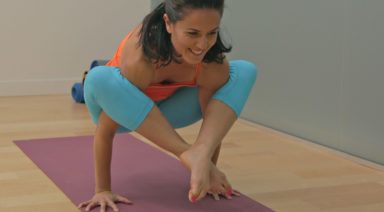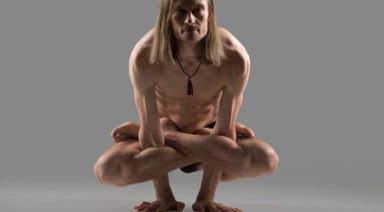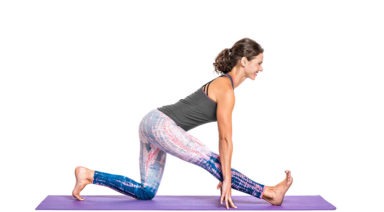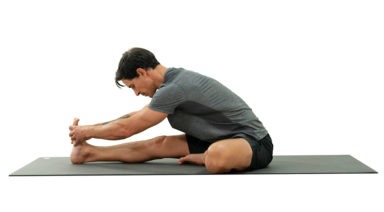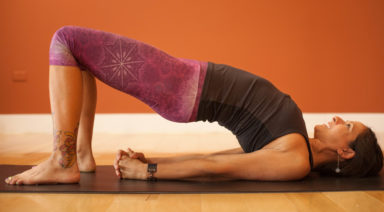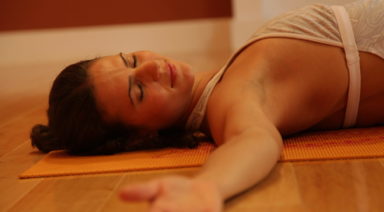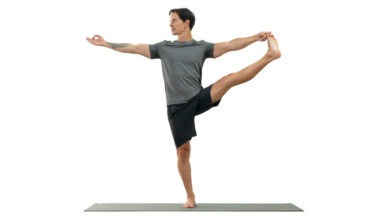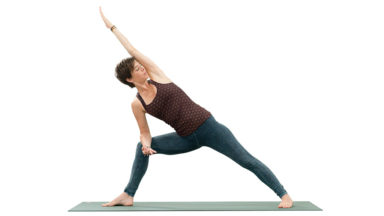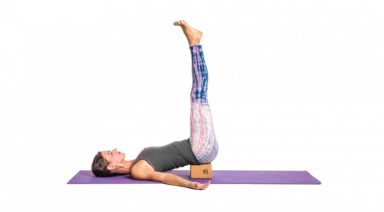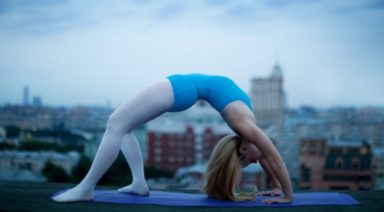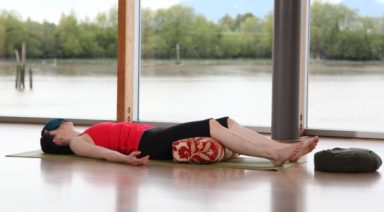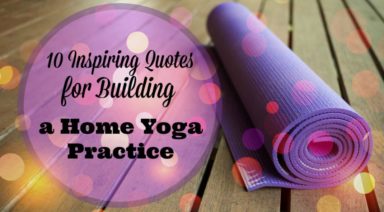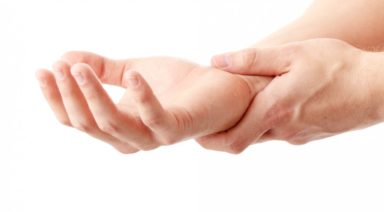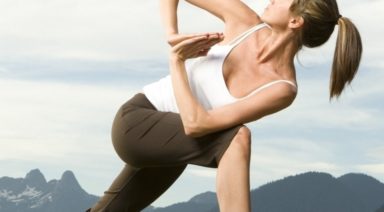Addiction Recovery Through Yoga
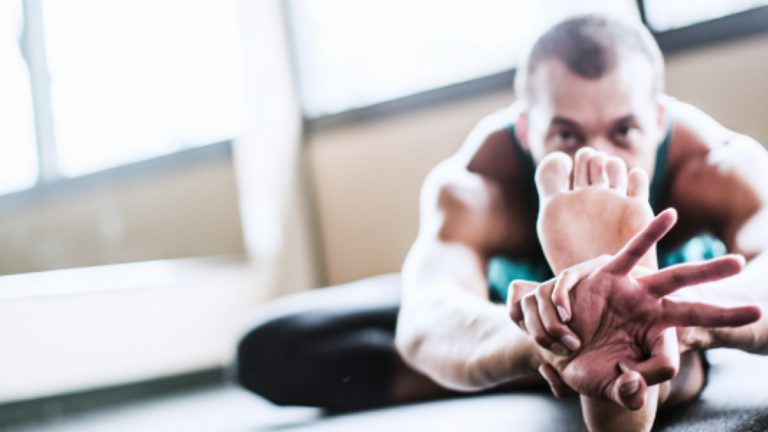
With all the images online of toned women in tights pulling themselves into pretzel-like poses, it’s easy to focus on the physical side of yoga, thinking of it as an exercise class that ends with a mini nap. But the ancient practice of yoga can also help with drug and alcohol addiction, diseases that affect millions of us in this fast-paced, modern world.
While yoga can be a powerful tool for personal transformation and recovery, many people write it off before even stepping onto a mat, saying they’re not flexible enough or they can’t afford the classes. Yet the mind-body connection, stress relief and personal growth that can occur through the regular practice of yoga can be just what a recovering addict needs. Yoga encourages a person to reconnect to their breath, body, mind and heart. Here are just a few ways yoga can help release the mind and body from the grips of drug and alcohol addiction.
Yoga Eases Stress
“It was such a crazy/stressful/hectic day… I need a drink” is such a common phrase in our culture, it’s easy to forget that there are healthy ways to cope with stress. Many addicts have become so dependent on their substance of choice, they’ve forgotten that movement or even just a few deep breaths can bring a real sense of calm to the day. And that moment of calm can lead to healthier choices as you move toward a sober life.
The benefits of mindful movement and breathing, which are at the center of many yoga classes, have been proven to increase overall health.
According to the American Institute of Stress, 20 to 30 minutes of deep breathing has been shown to help the body kick into a relaxation response, where stress levels drop and blood pressure decreases. “Deep breathing increases the supply of oxygen to your brain and stimulates the parasympathetic nervous system, which promotes a state of calmness,” according to an article on the organization’s website. “Breathing techniques help you feel connected to your body—it brings your awareness away from the worries in your head and quiets your mind.”
Nearly all yoga classes encourage students to consciously inhale and exhale, which brings peace to the mind and body, even as we move through a practice. If you commit even further, and regularly practice at home or at a studio, you might find yourself using deep breathing or a short yoga sequence to help you stay strong through a moment of temptation or stress.
This is especially important for addicts, as many suffer from post-acute withdrawal symptoms, or PAWS, in the early stages of recovery. These symptoms often include anxiety and mood swings. One study has shown that yoga directly helps to increase GABA, a neurotransmitter that aids in relaxing the nervous system, therefore improving your mood and decreasing anxiety.
Yoga Increases Self-Awareness
Addicts are often accused by their loved ones of being selfish. But devoting regular time to the kind of reflection that comes with yoga can be beneficial to those in recovery. More meditative types of the practice, like Yin Yoga, where there is little movement and just a few poses done in a single class, can create a meaningful space for really checking in with ourselves. While the questions that come to mind might not always be pleasant, these classes are set up as safe spaces for students to release emotions, and teachers are aware that their students might be struggling with all kinds of personal issues while in their studio. This type of contemplative yoga can help with anxiety, depression and even sleep issues. By dealing with some of the other factors that might be causing stress and unhappiness in your life, you might have more resolve or energy to commit to a recovery plan or time in a rehabilitation center.
Addressing the Roots of Addiction
Yoga is not superior in dealing with one addiction over another. Yoga begins to address the roots of a problem rather than the symptoms, making it a common tool among recovery from many addictions. If someone struggling with alcohol or drug addiction gets sober only to find him- or herself struggling with another addiction, such as food or gambling, yoga practices can be implemented to support in recovery from both addictions.
Yoga for General Wellbeing
Yoga can also be used as a tool to support general wellbeing regardless of addiction. For example, long deep breathing, or “yogic breathing,” has been shown to reduce levels of the stress hormone cortisol and increase stress resilience. Yoga can also be used to assist in dealing with trauma. According to Dr. Bessel van der Kolk, an expert in the field of trauma treatment, yoga may be more effective than many medications in treating PTSD. “Medication can be quite nice to sort of dampen some of the symptoms,” he states. “But in the end, people need to own their bodies, they need to own their physical experiences. And, in order to overcome your trauma, it needs to be safe to go inside and to experience yourself.”
Yoga asks you to show up for yourself. Although deep breathing can help relieve stress at any moment during the day, a physical yoga practice requires regularly carving out time for yourself. Even if you are just going to spend a few minutes stretching in your living room, you still must make the time to practice. As with any other type of physical exercise, you’ll see more benefits if you practice regularly. Yoga, for example, has been proven to ease chronic back pain and joint pain. Some studies have found that it can also help with mental health issues.
German researchers, for example, studied a small group of women who described themselves as “emotionally distressed.” Over a three-month period, they took two 90-minute yoga classes a week. At the end of the study, their stress, anxiety and overall health all improved. Similar studies have also shown the one-off benefits of even attending a single yoga class. The uniting factor in all of these cases? The participants showed up for themselves and attended a class. They might have had stressful days or felt anxiety about trying yoga or were plagued by depression, but they put all of that aside and spent the hour (or more) bending, breathing and stretching.
It’s easy to put off a yoga practice: to buy a mat or a DVD and let it go dusty. Or to attend a single class, but never step foot in the studio again. But the more you commit to yourself, and a regular mind-body practice, the more overall benefits you’ll begin to see and feel. A single healthy decision, like deciding to roll out your yoga mat, can change your focus for the day and encourage another healthy decision. Over time, those mindful moments will add up, perhaps leading to an overall more positive outlook and healthier lifestyle.
The Art of Surrender
Yoga requires us to surrender. The first of the 12 steps in Alcoholics Anonymous is “We admitted we were powerless over alcohol, that our lives had become unmanageable.” In a similar vein, yoga asks again and again that we drop everything that is not necessary in our lives. Most teachers will begin the class with a mind-clearing exercise and a short moment to set an intention. This helps us focus on the moment, and release all the other stresses in life. Similarly, some poses require surrender, as well.
Maybe there’s a complicated pose in class that you simply cannot twist your body into. That doesn’t mean you have to flop down on your mat or write the pose off for good. It simply means that accepting that today, that pose is not happening.
The same idea is true during some of the more “relaxing” poses. While your body might be still in a seated position, you may feel your mind racing. Again, yoga teaches us to simply surrender and to be present with who we are, where we are, right now. By engaging in a regular practice, we learn that acceptance comes with not being able to control the world around us but by allowing the world around us to exist as it is. By doing so we learn the art and gift of peaceful surrender.
In terms of learning to let go of expectations and limitations, yoga can be a boon for those who are recovering from addiction. In AA, the moment of surrender becomes “the firm bedrock upon which a happy and purposeful life is built.” The same is true in yoga: When we accept that a pose is out of our reach or that our minds cannot be quieted, we might finally find a moment of true freedom.
Spring Cleansing with Kriya, Asana and Pranayama

Spring has arrived once again and joyfully we begin to see budding flora & blooming fauna as they come out of winter’s hibernation. In Traditional Chinese Medicine, the liver is related to this fresh and vibrant season in which it is strongly influenced by. It’s a great time to assist the body in its natural cleansing process by toning and strengthening the liver organ so it can efficiently process and remove toxins from the body. This in turn will help to strengthen other body systems such as the immune, digestive & endocrine systems which will help to increase energy levels, promote radiant & vibrant skin, maintain healthy weight for your body type as well as promote a deep sense of peace & well being.
There are many ways in which we can support the body to reach and maintain optimal health & wellness, exercise, nutrition, relaxation and a healthy positive attitude…to name a few! Here are a few tips on using kriya, yoga asana and pranayama for toning, cleansing and strengthening the entire body and mind:
3-Part Breath – Dirga Pranayama
A deeply cleansing & grounding breath, helps to balance emotions, move stagnancy out of lungs, increases lung capacity, purifies toxins from the blood.
*Incorporate this breath several times throughout the day to focus attention to the present moment.*
Kapalabhati Breath – Breath of Fire
Cleanses the lungs & entire respiratory system, increases lung capacity, increases oxygen throughout entire body, massages digestive system improving overall function, purifies blood, brings balance into sympathetic and para-sympathetic parts of the nervous system, stimulates normal functioning of the endocrine system and tones abdominal muscles.
*Beneficial for those who experience seasonal allergies.*
Twists
Twisting poses release tension in the body, improve digestion, help to “wring” out toxins from the spine and other internal organs, tone the spinal nerves and improve the functioning of the spinal cord, flushing & cleansing action of the kidneys & liver, brings balance into the nervous system, massages & tones abdominal organs making it helpful to eliminate constipation, brings balance into the adrenal glands & hormone production, beneficial for menstrual disorders, improves round shoulders.
*Twists energize the body and can help give a boost when feeling sluggish or tired.*
Tapping
Face, head, neck, shoulders, chest, abdomen & low back) – boosts the immune system by increasing production of T-cells, reduces stress, energizing, increases focus, promotes strength & vitality, balances left of right hemispheres of the body.
*Tapping is a great “pick-me-up to increase focus and rejuvenate the body & mind”.*
Neti Kriya
Enhancement of olfactory senses, loosens and flushes dried mucous, dust and other pollutants in nasal cavity, reduces frequency & severity of colds & sinusitis.
*Neti Kriya is a beneficial practice for those who experience symptoms from asthma, allergies, sinusitis & hay fever.*
Cat & Cow Pose
Cat and cow pose massages and stimulates internal organs for increased digestion & detoxification, opens chest cavity for increased lung capacity, helps to expel stagnant matter from the lungs.
*If you feel the urge to cough while practicing this movement, allow yourself to do so to remove excess mucous from the lungs.*
Forward Bends – Uttanasana & Paschimottanasana
Forward bends massage abdominal organs, stretch & strengthen the spine bringing balance into nervous system, regulate digestion, menstruation & body temperature, calm & soothe the mind.
*Tones organs responsible for urination, defecation, ejaculation, menstruation and child birth.*
Shoulder Stand – Salamba Sarvangasanam
Shoulder stand pose stimulates blood and lymph flow to enhance detoxification, carries new blood to liver & kidneys which assists in increased detoxification, activates pituitary and pineal glands synergizing them to balance hormone levels in the body, increases blood circulation to the brain which will promote higher levels of concentration and mental sharpness.
*Because of the many benefits to this pose it is considered the “Queen of Asanas”.*
Meditation
Meditation is a subtle yet powerful practice to assist with cleansing & purification of body & mind, increases blood flow, decreases muscle tension, enhances energy, strength & vigor, increases focus & concentration, promotes self confidence, increases communication between the two brain hemispheres, grows a stable, more balanced personality, helps keep things in perspective, helps us tune into the present moment and experience a sense of “oneness”.
*Meditation can be practiced by anyone regardless of spiritual or religious practices, age, or gender.*
HAPPY CLEANSING!
Join Gaiam TV for the Conscious Cleanse!
Join us as we go through a 14-day clean eating and yoga challenge. We’ll guide you through a journey of personal growth and transformation using clean, from-the-earth nutrition paired with detoxing yoga practices from the best yoga teachers around.
No calories to count, no supplements to buy. This is a back-to-the-basics approach to simplify all of the things you put into your body – nutrition, exercise, and thoughts.





